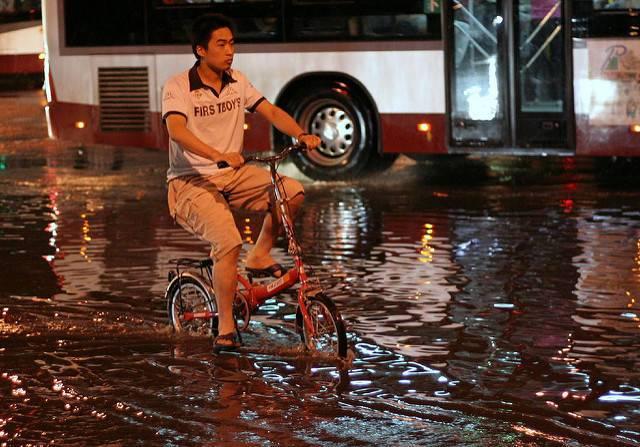
In the coming weeks, experts anticipate that Houston residents will be at risk for something normally only seen in disasters in developing countries: the spread of infectious disease brought on by exposure to contaminated floodwaters and crippled infrastructure.
The Texas Department of State Health Services is already preparing for what some fear could morph into a public health crisis with insufficient potable water, high humidity and bacteria-laden floodwaters that will take time to recede.
That's because Houston has a serious design problem. While many have been quick to blame the city's record-breaking flooding on Hurricane Harvey, the real problem points out The Atlantic's contributing editor Ian Bogost has less to do with record-breaking rainstorms and everything to do with planning and design.
"The reason cities flood isn’t because the water comes in, not exactly. It’s because the pavement of civilization forces the water to get back out again," explains Bogost.
It's not a unique problem, either. San Diego faced the issue in the 1980s when a series of record storms flooded out streets, destroyed homes and forced the city to apply for emergency disaster funding. The problem was poorly designed infrastructure that wasn't up to record-size rainstorms.
But Houston's deluge highlights another problem: climate change will be even more difficult to manage in an environment already at risk to chronic flooding.
In recent years, local institutions like the Houston Medical Center and the NASA Johnson Space Center have worked hard to address environmental risks. Tropical storm Alison taught the country's largest medical center a valuable-if-painful lesson about unexpected crises when its bottom floor flooded, killing thousands of laboratory animals, decimating irreplaceable records and forcing emergency evacuations.
NASA's proactive efforts at the Houston facility paid off this week during the siege from Hurricane Harvey.
TriplePundit has written on these efforts in the past, highlighting the strides that were made through climate mitigation. But even though both Houston facilities appear to have weathered Hurricane Harvey, the ability of the city's critical medical system to treat patients quickly was hampered by the fact that the rest of the city had not taken similar steps to mitigate the impact of environmental hazards like flooding.
What's interesting is that the city has been at the forefront of green city initiatives. It endorsed the "We Are Still In" campaign. It has maintained its website on climate change and sustainable living, despite the fact that it notes the Environmental Protection Agency removed the information from the federal site in April. Its efforts are complemented by a separate initiative, the Houston Advanced Research Center (HARC), which promotes "independent analysis on energy, air, and water issues to people seeking scientific answers."
But as in a growing number of cities, those efforts haven't yet dug below the seeming inpenetrable layer that poses the greatest challenge for addressing climate change: Houston's concrete infrastructure.
Other cities face similar problems. In 2013, the city of Wuhan, China, realized it had a problem. Known euphemistically as the "city of a hundred lakes," Wuhan has found in recent years that it's the streets, stadiums and buildings, not the natural bodies of water, that now serve as retention areas for the region's copious rains. The problem, in short, is concrete -- and a failure to build drainage systems that can keep up with burgeoning city expansion.
So far, Wuhan's upgrades have yet to be completed. According to researchers at CLIMSystems in New Zealand, numerous delays by the government have pushed the completion date off to 2018. But as in Beijing, where dozens of deaths were attributed to flooding in 2012, engineers know that city expansion and proper design are at the heart of mitigating climate change. According to engineers, Beijing was able to control flooding problems during a rainstorm 2016 because it had upgraded its sewage system to meet population demands.
As West Coast U.S. cities are finding, climate change mitigation doesn't just mean putting up higher sea walls or building submarine doors for its medical facilities. but keeping ahead of the infrastructure needed for population and real estate expansion. But Houston's topography begs another question, one that is going to be even harder to address in coming years: Are there environmental settings in which populations should be limited? Can a low-lying plain with poor drainage soils, heavy rains support unlimited community expansion?
To be sure, population control is a highly unpopular debate in the U.S. And as is so often the case, unpopular issues tend to spawn better, more acceptable answers. But if there's any message to be gained from Harvey's landfall this weekend, it's that climate change mitigation is a must, even if the Trump administration's new executive order puuts safe building mandates benind.
Flickr images: Hurricane Harvey -- The National Guard; Beijing -- Ernie
Jan Lee is a former news editor and award-winning editorial writer whose non-fiction and fiction have been published in the U.S., Canada, Mexico, the U.K. and Australia. Her articles and posts can be found on TriplePundit, JustMeans, and her blog, The Multicultural Jew, as well as other publications. She currently splits her residence between the city of Vancouver, British Columbia and the rural farmlands of Idaho.














